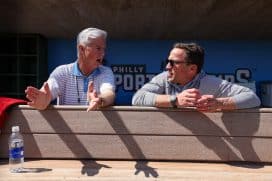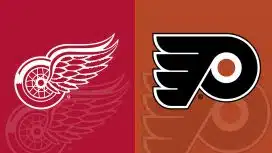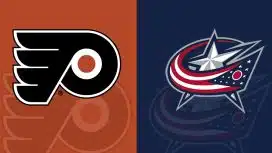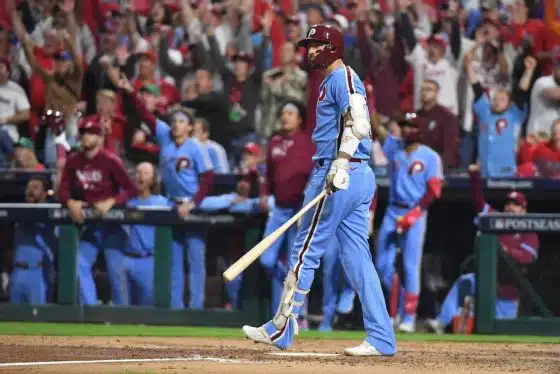Writer: Kevin Durso
Making Memories: Reliving the Phillies’ First Half
Posted by Kevin Durso
The halfway point of the season is now officially upon us, an after playing 91 games, the Phillies are sitting atop the standings in all of baseball. Just as we all expected, right? Well, maybe not completely as expected, because this Phillies’ season has been anything but ordinary so far. With the All-Star Break here, we look back at some of the Phillies’ top moments so far this season, as well as highlight some of the best plays and players of the first half.
Best Game
Is there any question what game is going to be talked about here? It’s hard to ignore a 6 hour, 11 minute marathon that ends with your third baseman playing second, your catcher playing third, and your backup second baseman on the mound…as the winning pitcher. The Phillies’ May 25th match against the Cincinnati Reds featured two solid outings from the starters, incredible bullpen pitching, and some very clutch hitting.
An early 3-0 Phillies’ slipped away, and the end result looked even worse as Jay Bruce homered off Antonio Bastardo in the tenth. Ryan Howard answered that call, homering off Francisco Cordero to tie it. That led to a full nine innings of baseball with nothing on the board. Pitchers kept coming and going: Bastardo, to J.C. Romero, to David Herndon, to Danys Baez, to more Danys Baez, to Wilson Valdez.
With every inning pitched, the bullpen made itself shine. And when the bullpen that night featured a position player, and still silenced the Reds, it was icing on the cake. Finally, over six hours, and 19 innings, later, Raul Ibanez connected on a sac fly to center. In the end, it sounds like the most anti-dramatic play you could end such a game on, but knowing just how important the next run was, it was as exciting as ever. The final score was 5-4.
Best Plays/Moments
Because it is often so difficult to pick the best plays or moments, we’re giving a top five of sorts. These are in no particular order, but you can use your imagination here. Note that because it was already picked as the game of the first half, there will be no mention of a Raul Ibanez sac fly in the 19th or a scoreless inning from Wilson Valdez.
1. The best place to begin is where this all got started. A ninth-inning rally, featuring RBI singles by Ben Francisco, Wilson Valdez, and finally John Mayberry Jr. to win it, gave the Phillies their first win of the season on Opening Day. You couldn’t have written a better script to this ending, but it truly defines just where this team was heading.
2. One play that sticks out in my mind is one that happened in the ninth inning of a game on June 10th. Leading 7-0, the Phillies let the Chicago Cubs trim that to 7-5. With the tying run at the plate, Mike Stutes struck out Starlin Castro, and as the ball was mishandled by Carlos Ruiz at the plate, Darwin Barney thought he had a chance to take second. Chooch scooped the ball in his glove and fired a dart to second in time to nab Barney for a double play. It preserved the Phillies’ lead, as Carlos Pena followed in an at-bat against Antonio Bastardo, and struck out to end the game.
3. Again, some of these plays are about hustle and heart. One such play happened on April 6th against the New York Mets. After allowing a 7-0 lead to fade away to a 7-7 game, Placido Polanco drove in the go-ahead run in the sixth. On second base with two outs, Ryan Howard drilled a ball back up the middle and off the pitcher. As it rolled to second, it was clear Howard would be safe, but Polanco was racing around third to try and score. He slid head-first just ahead of the tag, and padded the Phillies’ lead.
4. This little section is simply a follow up to an article that came before this. Cliff Lee has done it all, from his three-RBI game on May 26th, to his three straight shutouts ranging from June 16th to June 28th, to his solo home run on July 9th. The shutouts are somewhat expected because of the type of pitcher Lee is. What you probably didn’t expect was to see this guy strike out 16, make some unbelievable plays off the mound, or hit for a better rate than some of the regular starters in his own league. But this goes further than just his accomplishments on the field. April 2nd marked Lee’s official return to the Phillies’ rotation, and every Phillies’ fan knew the reason he was back in Phillies’ pinstripes. That made him a hero without doing anything more than just wanting to be here, and be a part of this team. So, as he exited the Phillies’ dugout for his pregame warmup, he got a huge ovation. It was even louder as he walked in from the bullpen as the starting lineup was introduced. If you want to talk about superstars, then go ahead and point out all sorts of top-notch players who wouldn’t have done what Lee did. That type of superstardom puts Lee in a class of his own.
5. This last spot goes to all the dramatics of the season. The Phillies have five walk-off wins to this point. The first, an Opening Day thriller that featured three runs in the ninth. Their second, the game-winning sac fly from Raul Ibanez in the 19th. The third, a walk-off single in the tenth by Carlos Ruiz. The fourth, a bouncing single over the head of the third baseman in the ninth inning of a scoreless game. And finally, Raul Ibanez was at it again when he hit the Phillies’ only walk-off homer to this point, a solo shot in the tenth just days ago.
Most Valuable Player
There are many places I could go with this one. For one, the Phillies have five All-Stars, and that’s not without reason. But, when you figure that some of the team’s best players aren’t joining those five teammates in Arizona, like Ryan Howard, Carlos Ruiz, Chase Utley, and Jimmy Rollins, you wonder just who really is the most valuable to this team.
I’m going to make this a bit easier. Forget all those names, because my pick for Most Valuable Player comes from one of the five All-Stars. Let’s make this easier; it’s one of the aces. So, now we’re down to three possible choices.
Surely it must be the Phillies’ rock star extraordinaire; the one with three straight shutouts. No, it’s not Cliff Lee.
Well, then, it must be the reigning Cy Young Award winner, the one well on his way to repeating the same numbers he put up in that sensational season. No, it is also not Roy Halladay.
The Phillies’ Most Valuable Player so far this season is Cole Hamels. It’s easy to pick Hamels on his numbers alone. He’s tied for the team lead with 11 wins. He is third among the aces in strikeouts with 121, but ranks fifth in the league. He’s also got the third lowest ERA in baseball, 2.32. That is the main factor in ranking Hamels ahead of Halladay and Lee.
Hamels’ ERA of 2.32 beats Halladay’s 2.4 ERA, and Lee’s 2.82 ERA. Halladay and Hamels are essentially neck and neck. Their records at the break are nearly identical; Halladay at 11-3, Hamels at 11-4. But, when you look at many things about Hamels that don’t show up in the box score, that’s what makes him better.
Hamels is only 27 years old, and the youngest of the aces. Halladay is 11-3, and that’s no surprise, because time and time again, he’s won his own ballgame. Lee at 9-6 is essentially the same, because with each into their 30’s, both the age of the number on their backs, they have made that their game. It is now their molded mindset to try to win at all costs, leave it all on the field, and do it as calm, cool, and collected as possible.
There was a time when Cole wasn’t so cool. He had the ability, but he lacked the composure. Mainly, it was a sign of his youth. He was so successful at a young age, so that when he was 23 and asked to step up as one of the Phillies’ top pitchers, he like many of the other 20-something Phillies, who were all playing their first Postseason series in 2007, fell victim to the hype and lack of experience.
In 2008, with a little experience, and perhaps more luck, they achieved greatness. But, for Hamels, greatness came with a price. After winning NLCS and World Series MVP in 2008, Hamels struggled in 2009. He wasn’t anything close to his pitcher, and after looking like the greatest pitcher to wear pinstripes since Steve Carlton, in 2008, he looked miles away from that in 2009.
The maturity and composure that was present in 2008 was gone, and Hamels gave the presence of a weak kid, ready to be victimized by the bully once again.
2010 was more of a redemption year. He had learned a thing or two from pitchers who were well on their way to Hall of Fame discussion at the least. Cliff Lee, Pedro Martinez, Roy Halladay, and Roy Oswalt all passed through the clubhouse in a matter of a year, and it definitely made a mark on Hamels.
Now, at 27, he’s emerged as the Phillies’ best through 91 games. Certainly not where you expected the youngest horse to be, but it’s the type of surprise that rivals your wildest dreams on Christmas morning. I picked Cole Hamels to win 17 games in 2011, and gave the real bulk of the work, if you will, to the two pitchers I thought were the most real of the four aces.
Turns out, Hamels is working very hard to prove me wrong. The ten losses I gave him certainly don’t look like they’ll stack up at the end, and neither does that number: 17. This season, Cole looks like he has his sights on a different number, one that Roy Halladay seems to target every year: 20.
Biggest Disappointment
I hate to do this, because being such a big Phillies’ fan makes it hard to actually put one of your own down. But this is more about disappointment. Sometimes, players are going to let us down. If Cliff Lee didn’t light the world on first in June, this could have gone to him. He was only 4-5 at the end of May, and that certainly didn’t seem right.
You might also be thinking this could go to a guy like Roy Oswalt, Joe Blanton, or Chase Utley. No, injuries are not an excuse, and each of them were all playing well at one stretch during the first half of the season. I’ve looked over the entire roster. In order to be such a big disappointment, you have to have high expectations, and a lot to do with the success or otherwise of the team. In that case, Carlos Ruiz’ lack of offense doesn’t make him a disappointment.
Nothing is wrong with the rotation, which he calls, and his defense is outstanding. Some players who would normally be classified as the disappointments have had one outing that has saved them. Kyle Kendrick threw a one-run gem against the Marlins…in a spot start. Danys Baez threw five scoreless innings in relief…and did it from innings 14 to 18. Wilson Valdez pitched…need I say more.
The Phillies’ biggest disappointment this season to me is Ben Francisco, simply because there is no player that leaves you more frustrated. That…and the fact that Francisco has seemingly lost his starting job. He started the season off on a tear. Then, he faded. He faded so much that the Phillies had to call up Domonic Brown just to revitalize the offense.
Brown’s numbers aren’t much better than Francisco’s, but he’s in every game anymore, and he has made right field his. He patrols it, and even when Francisco gets a start, it’s more like they are molding left field for post-2011 Francisco, with the likely exit of Raul Ibanez lurking on the horizon.
If the player with the expectations to carry most of right field has surrendered the starting job to a rookie, one who the Phillies were reluctant to give a chance to in April; that makes Francisco a pretty big disappointment.
Biggest Surprise
This one is a tough choice as well because of everything that has changed about the Phillies since Opening Day. They have battled with injuries and had players fill in everywhere, and they still have an excellent 57-34 record.
If pitching has been the answer for quite a bit of the Phillies’ success, then it has to be a pitcher here as well. There were really three choices. One of them appears later in a different category. The other is very much esteemed, but just not quite what I was looking for in this category,
The pitcher I’m talking about as the biggest surprise is Mike Stutes. Seriously, did anyone know who this guy was before Spring Training? He burst on the Clearwater scene, and caught the eyes of many, including myself. I noted that of all the previously unknown players making names in Spring Training, Stutes was the one to watch.
Stutes' chances of making the club on Opening Day were slim, but as each round of cuts went by without his name falling from the list, you knew the Phillies saw something they liked. By the end of April, Mike Stutes was in Philadelphia, not Lehigh Valley, and he was dealing from Day 1. But, it took him over a month, into June, to pick up his first Major-League victory. And at a time when the Phillies were struggling to find a few wins, every win the Phillies got seemed to put Stutes in the winner’s column.
But, Stutes has been more than just the winning pitcher three times. He’s been forced to grow into a role for the most experienced and focused of relievers, and do it almost immediately in coming to the Majors. He’s not a closer, but he is serving as the set-up man right now, and was always a set-up option even before injuries elevated his status.
He pitches well, he comes through in the clutch, and he certainly doesn’t look like a rookie. He’s caught the rest of the National League off guard, and that gives the Phillies one more solid arm out of the bullpen.
X-Factor
If you were expecting this name to show up in the biggest surprise category, here’s why he didn’t. The Phillies’ x-factor so far is Antonio Bastardo. And how can he not be? He’s developed into a closer, and gives the Phillies some legitimate reason to let go of both Brad Lidge and Ryan Madson, both free agents, following this season.
If the Phillies are impressed by Madson’s abilities as a closer, take a look at Bastardo’s abilities in close ballgames. He, like Stutes, have been given the call in spots that take a veteran’s mentality.
Bastardo is starting to show he has what it takes to be a closer, much like many of the Phillies’ bullpen options.
But, Bastardo has a way of blowing away hitters with his fastball, then making them look silly with junk pitches. He reaches speeds with his fastball that others can’t. He has been thrown into the closest of ballgames and escaped with little or no damage, evident by his microscopic 0.82 ERA, which leads National League relievers.
The more that he succeeds, the more the Phillies have to decide who they really want their closer to be beyond 2011. But, for this season, they have more than enough people capable of pitching late in games. Bastardo is just one of them, and the difference between him and Stutes: when injured relievers like Madson, Contreras, and Lidge all return, Stutes will be shuffled to the back. Bastardo might just get to keep his new found role.












































